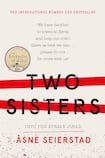
The premise: on an October morning in 2013, two teenagers of Somali Muslim extraction, 19-year-old Ayan Juma and her 16-year-old sister Leila, leave their adopted home in Oslo to travel to Syria and join Islamic State. They’ve been preparing for the journey for months, stockpiling funds acquired through mobile phone contract scams and credit card fraud.
When their father Sadiq receives an email from the girls later that same day, he resolves to intercept them in Turkey, but by the time he arrives in Antakya they’ve already crossed the border into northern Syria. Sadiq follows and establishes contacts among the local rebel forces. Weeks of waiting and speculation follow before he learns the truth: his daughters were not brainwashed – they have defected of their own free will and have no plans to return. Ayan has, in fact, married an Islamic State fighter. Sadiq persists in his attempts to establish contact with his daughters but is accused of being a spy, detained and tortured for almost two weeks. Traumatised, he returns to Norway to contemplate his next move. What follows is a further three years of abortive rescue schemes and agonising intrigues.
The above is not a synopsis of a high-concept Hollywood thriller by some A-list screenwriter with one eye on the newsfeed and the other on her bank balance. Two Sisters is Norwegian writer Asne Seierstad's nonfiction account of an emigrant family torn apart by Islamic extremism, and a roadmap of how relatively comfortable and well-educated youth can become radicalised to the point of jihad.
This is very much Seierstad's territory. Over her 25-year career as a war correspondent she's covered numerous conflicts, reporting from Russia, China, Iraq and Afghanistan, publishing books on Serbia, Baghdad and Chechnya. Her best-known work, The Bookseller of Kabul (2001), sold more than two million copies. Two Sisters often reads like a high-octane novel, with reconstructed set pieces and exchanges of dialogue, although Seierstad's prose is closer to old-fashioned war reportage than new journalism, with the accent on content rather than style.
No interviews
Here, craft and technique are paramount. The story's two central protagonists refused any interview requests, so Two Sisters is constructed around their absence. In the short essay that concludes the book, the author outlines her working methods, explaining how she interviewed the girls' family, classmates, teachers, principals and others, drawing on essays, report cards, class photographs, evening courses and online correspondence, as well as logs of conversations conducted on Messenger, Viber and WhatsApp.
“How should you portray people you have never met, who do not want to tell you their side of a story?” she writes. “One guiding rule is to begin with actions: What did they do? When? What do we know from written sources? What do people around them say they said, wrote or did? A book within the genre of literary journalism is composed of scenes that build upon one another. These scenes are reconstructions. The better the sources, the more accurate the scenes will be. Where I describe a person’s thoughts, they are based on what that person said he or she was thinking about in a given situation, or what people in the book told others that the individual was thinking.”
Asne Seierstad's book functions as an education as well as a witnessing
Two Sisters is not just a page-turner: it also provides the reader with important insights into the psychopathology of Islamic State, as well as the complexities of the Syrian conflict. The West's inability to respond in any meaningful way to Syria as a humanitarian disaster is perhaps the greatest source of 21st-century liberal shame. The reason why the greater public hasn't responded to what is in effect a modern-day holocaust boils down to what might be called atrocity marketing. The Syrian civil war involves multiple protagonists, ever-changing allegiances and shape-shifting players. Few casual observers can figure out what's going on between the many rebel splinter groups, the Free Syrian Army, Assad's forces, the Russians, Nato, the Americans and Islamic State.
Lucidly written
Despite horrific footage of refugee camps, live blogs and drones capture, and the horror-show shots of dead babies and capsizing rafts, the conflict has failed to elicit anything like the mass emotional response of the Ethiopian famine or the Haiti earthquake. It’s as if Aleppo has been damned as the devil’s playground, a theatre of proxy conflict in which superpowers get to test new technologies and postmodern warfare techniques, with unfortunate but unavoidable collateral human damage.
In this context, Seierstad's book functions as an education as well as a witnessing. A chapter entitled Blueprint is just that: a condensed but lucidly written history of Islamic State's jihad campaign: how their ranks were bolstered by foreign fighters, many European; how they exploited the possibilities of online psychological online warfare, disseminating images of the beheading of Western journalists as retaliation for Obama's air-strikes; and how they came to establish a caliphate following their seizure of a section of the Syrian-Iraqi border in 2014.
Into this modern-day inferno two teenaged sisters fled, against all reason, their father in pursuit. If the ordeal is unimaginable to most Europeans, the mythic resonances are powerful: Orpheus descending into the underworld to rescue Eurydice. The result is a book destined to become regarded as one of the year’s nonfiction landmarks.
Peter Murphy is the author of the novels John the Revelator and Shall We Gather at the River










